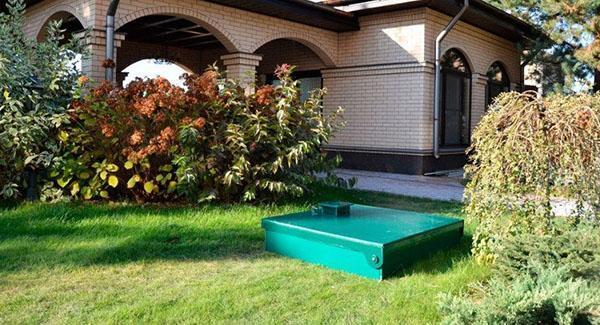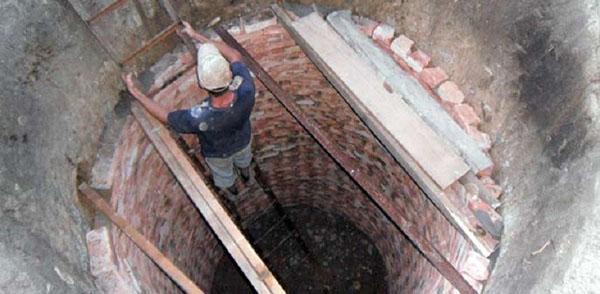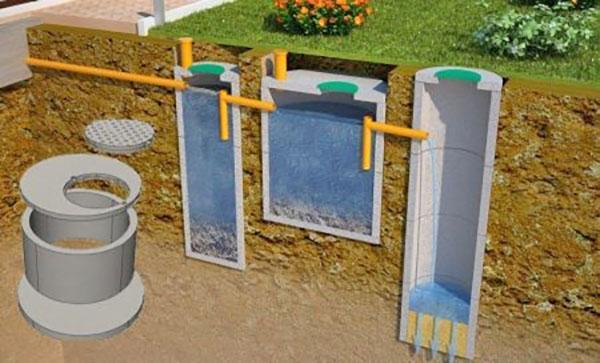Autonomous sewerage in a private house: selection rules and organization features
 Suburban low-rise buildings need to organize wastewater treatment. Autonomous sewerage in a private house is a modern way to solve the problem in the absence of a centralized system.
Suburban low-rise buildings need to organize wastewater treatment. Autonomous sewerage in a private house is a modern way to solve the problem in the absence of a centralized system.
Types of sewerage systems
The careful selection of sanitary ware for the home and its elegant integration into the interior of bathrooms, toilets and kitchens must necessarily be complemented by thoughtful wastewater disposal. In the absence of a centralized sewerage system, this problem requires the selection of an option, taking into account the requirements for each specific case.
Before choosing the most suitable option for organizing wastewater in a particular case, you must familiarize yourself with all possible methods. There are several ways to dispose of wastewater (fecal and industrial water).
Cesspool

A special tank is used as a storage tank, which is pumped out by the sewage service. A container is made of concrete, steel, or a ready-made one is purchased from plastic. In case of poor-quality installation, in addition to waste water, surface water can enter the tank, as well as depressurization.
The size is determined based on the water consumption of the residents of the building. For example, for a family of 3 people, a cesspool with a volume of 10 m³ will need to be cleaned about once every half a month.
To remove drains and clean the tank, you need to call special vehicles. Depending on the volume of the wastewater tank and the intensity of its use, the pumping frequency can reach 2-4 times a month. The organization of the accumulation system is considered the cheapest, but its maintenance with the involvement of sewage equipment is expensive.
Advantages of the accumulative home autonomous sewage system:
- quick and easy installation;
- democratic cost of materials;
- primitive construction;
- no dependence on electricity.
Cons of the system:
- an unpleasant odor is likely;
- the need to use the services of sewers, which is not cheap;
- when soil is clogged, it becomes necessary to organize a new storage system.
When organizing a cesspool, it is necessary to foresee in advance the possibility of access to the tank of a sewer truck.
Septic tank with mechanical cleaning

This method is one of the most popular. The advantages of this method are:
- rare cleaning - about once a year;
- no electricity supply required;
- uncomplicated organization system;
- relative ease of installation.
The principle of the device using multiple cameras:
-
- Through the system of sewer pipes, wastewater enters the tank and settles.
- After partial settling, the effluent flows into an adjacent tank and settles again.
- Transfer of liquid to the tank for additional treatment. At this stage, those contaminants that have not settled in the previous containers are sifted out.
The disadvantages include the low quality of cleaning (about 60%) and the need for subsequent post-treatment. For high-quality wastewater treatment, drainage wells, drainage blocks or filtration fields will be needed.
The option is selected taking into account:
- soil composition;
- the passage of groundwater;
- terrain.
The disadvantages of the system include:
- not a sufficiently high degree of purification;
- possible unpleasant odor
Septic tanks with biological treatment
 It is a modern and highly efficient cleaning method recognized as one of the best environmentally friendly options today. There are several options for autonomous sewage systems in a private house, which are based on the principle of biological treatment.
It is a modern and highly efficient cleaning method recognized as one of the best environmentally friendly options today. There are several options for autonomous sewage systems in a private house, which are based on the principle of biological treatment.
The most popular and reliable systems include: Topas, Tank and others, which provide a high level of effluent filtration. Their operation is distinguished by noiselessness, and the units themselves combine ergonomics and reliability while respecting the environment.
Features of the organization:
- Mandatory presence of a compressor and a supply of electricity, since in its absence the system does not work.
- Efficiency is the main asset.
- Long service life - tens of years.
- No pollution to the environment.
- Lack of unpleasant odor.
- High degree of wastewater treatment.
- The feasibility of installing such a system depends on the intensity of use of the system. With a rare visit to a country house, the costs can be unreasonably large.
Deep biological treatment stations are several sealed containers. Multilevel cleaning is achieved using a series of chambers and aeration. Each camera in the system has its own function.
The principle of operation of an autonomous sewage system of a private house by the method of deep biological treatment:
|
Camera number
|
Principle of operation |
Note |
| 1. | Wastewater inflow, their fractional separation (heavy particles precipitate) | This is the largest container in size |
| 2. | With a special jet pump or the use of another device, wastewater is supplied to the chamber, where anaerobic microorganisms act on organic compounds | In this tank, an active decomposition phase is carried out, during which intensive biological processes of oxidation of organic contaminants occur. |
| 3. | Secondary treatment (aeration) | The chamber is a settling tank in which the next stage of post-treatment takes place |
| 4. | Removal of purified water | Final removal of liquid from the purification complex |
With proper installation, wastewater treatment in this way reaches almost 100%.
Autonomous sewerage in a private house: recommendations for choosing
When choosing an autonomous sewage system, it is advisable to lay down the following requirements:
- autonomy of work (without the need for constant monitoring);
- efficiency of functioning;
- calculation of the peak load of the treatment system (maximum possible discharge) to prevent overflow;
- SNiP standards;
- the installation of the system should take into account the number of people living in the house, which affects the frequency of using plumbing.
In addition to the listed points, additional physical and geographic parameters are necessarily taken into account. A significant difference in how the autonomous sewerage system of a private house works is in the actual purification of runoff water, and not in their accumulation.
Sewerage depth
 In cases where the sewerage in the house was installed before the treatment plant, the depth of the outlet of the sewer pipe from the foundation must be taken into account. This limitation affects the further organization of the treatment plant, and affects the cost.
In cases where the sewerage in the house was installed before the treatment plant, the depth of the outlet of the sewer pipe from the foundation must be taken into account. This limitation affects the further organization of the treatment plant, and affects the cost.
Performance
 This parameter should correspond to the load of the wastewater intake, namely, the calculation of the volume of liquid that passes over a certain period of time, taking into account the size of the tank. The actual throughput must match the specifications.
This parameter should correspond to the load of the wastewater intake, namely, the calculation of the volume of liquid that passes over a certain period of time, taking into account the size of the tank. The actual throughput must match the specifications.
Manufacturing material
 The properties of the material used to manufacture the treatment system impose requirements on the process of operation, installation and subsequent maintenance.
The properties of the material used to manufacture the treatment system impose requirements on the process of operation, installation and subsequent maintenance.
In the process of organizing a treatment plant (depending on the system), the following materials can be involved:
- metal;
- concrete;
- fiberglass.
Power supply and its paramount importance
 For a local wastewater treatment plant that requires an electrical connection, uninterrupted power supply is very important. The latest generation systems include sensors, compressors, pumps and other elements, the work of which is dependent on power supply.
For a local wastewater treatment plant that requires an electrical connection, uninterrupted power supply is very important. The latest generation systems include sensors, compressors, pumps and other elements, the work of which is dependent on power supply.
Geographic conditions: what to look for
 When installing the system, the terrain (natural slopes) must be taken into account, the presence reservoirs, type of soil, passage of groundwater. Depending on the type of soil, the installation of the system can be complicated, which ultimately will affect the cost of the work. Ground waters, their depth, affect the complexity of the installation of the treatment system and the likelihood of flooding the site.
When installing the system, the terrain (natural slopes) must be taken into account, the presence reservoirs, type of soil, passage of groundwater. Depending on the type of soil, the installation of the system can be complicated, which ultimately will affect the cost of the work. Ground waters, their depth, affect the complexity of the installation of the treatment system and the likelihood of flooding the site.
If there is no experience in organizing such structures, the work should be entrusted to professional craftsmen.
It is necessary to install an autonomous sewage system taking into account the following requirements:
- no closer than 5 meters from the building.
- at least 30 meters from the source of drinking water.
Costing principles

The cost of installing a wastewater treatment system depends on many factors:
- type of treatment plant;
- septic tanks;
- site features (size, soil composition);
- complexity and volume of work;
- material consumption.
To accurately calculate the estimate, you need to call a specialist to the place.
Construction stages

The device of an autonomous sewage system takes place in compliance with certain stages:
- Design, selection of the best option.
- Digging a pit.
- Installation of the system in the pit.
- Summing up and joining.
- Filling the pit.
- Complex testing.
- Launch.
Depending on the characteristics of the site, the expected load of the system and the area, you can choose a suitable system that can create comfort for the residents of the house. A good organization of drainage for a cottage is an autonomous sewage system in a private house using biological purification methods. These systems are reliable, environmentally friendly and highly efficient.